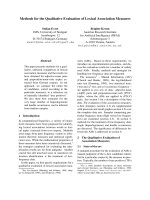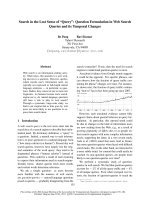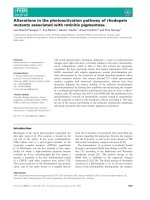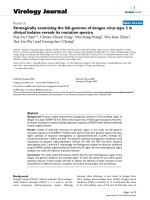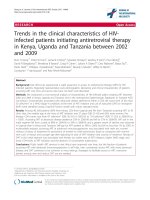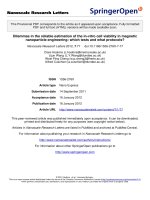Báo cáo sinh học: "Pitfalls in the phylogenomic evaluation of human disease-causing mutations" potx
Bạn đang xem bản rút gọn của tài liệu. Xem và tải ngay bản đầy đủ của tài liệu tại đây (109.58 KB, 5 trang )
Minireview
PPiittffaallllss iinn tthhee pphhyyllooggeennoommiicc eevvaalluuaattiioonn ooff hhuummaann ddiisseeaassee ccaauussiinngg mmuuttaattiioonnss
Andrew OM Wilkie
Address: Weatherall Institute of Molecular Medicine, University of Oxford, John Radcliffe Hospital, Headington, Oxford OX3 9DS, UK.
Email:
The explosion in genome sequencing provides a rich
resource for reconstructing the evolutionary origins of gene
families. One proposed application for such phylogenomic
information is to identify highly conserved sequences in
human proteins suspected of being associated with disease,
and to use this information to identify sequence variants in
these regions as potential disease-causing mutations. A
recent example of this approach is a study by Finnerty et al.
of the MSX homeobox family published in BMC Evolu-
tionary Biology [1]. MSX is of particular interest because it
represents one of the most ancient families of animal
homeodomain proteins, and mutations in both paralogous
human genes, MSX1 and MSX2, have been associated with
craniofacial disorders [1,2]. The work by Finnerty et al. [1],
which focuses on the MSX1 sequence changes, provides a
useful case study in the context of current initiatives to
generate large amounts of genomic sequence data from
complex diseases. These will yield thousands of rare
sequence variants, causing headaches for interpretation of
the pathogenicity of individual sequence changes. So, how
successful has the analysis of MSX sequences been in aiding
interpretation of human MSX1 sequence variations?
HHuummaann MMSSXX:: eevvoolluuttiioonn aanndd ddoommaaiinn oorrggaanniizzaattiioonn
The human genome contains two MSX paralogs, MSX1
located at 4p16.2 and MSX2 at 5q35.2. There is strong
evidence that these genes arose from the second round of
whole-genome duplication that took place at the base of the
vertebrate radiation (the additional two copies expected
from these duplication events have been lost in humans,
but rodents retain an Msx3 gene predicted to have split from
Msx1/Msx2 at the first duplication event).
Apart from the well-known homeodomain (‘MH4’), Finnerty
et al. [1] confirm and extend a recent analysis [3], finding six
other highly conserved sequence elements within human
MSX proteins, which they term MH1N, MH1C, MH2, MH3,
MH5 and MH6 (Figure 1a). The elements MH1N and
MH1C exhibit homology, suggesting that they arose from
an ancient duplication of a Groucho-binding domain;
MH1C has been secondarily lost in MSX2 (and inde-
pendently in rodent Msx3), but is retained in MSX1. MH6
near the carboxyl terminus is a newly identified motif and
represents a PIAS-binding domain. Finnerty et al. [1]
convincingly demonstrate that use of phylogenetically deep
AAbbssttrraacctt
A detailed sequence comparison of the MSX homeobox family sheds light on its evolution and
identifies new conserved motifs. But in the absence of corroborative genetic data, phylo-
genomics alone can provide only limited insights into the pathogenicity of heterozygous
missense substitutions in human genes.
Journal of Biology
2009,
88::
26
Published: 24 March 2009
Journal of Biology
2009,
88::
26 (doi:10.1186/jbiol127)
The electronic version of this article is the complete one and can be
found online at />© 2009 BioMed Central Ltd
sequence comparisons can aid alignment of the more
poorly conserved regions of the MSX proteins.
Having undertaken this alignment, sequence changes found
in human MSX1 in samples from patients with either tooth
agenesis or cleft lip/palate (CL/P) were mapped in relation to
the conserved sequence elements, to help predict the severity
of their functional effects [1]. Here I will focus on the
missense changes, as these are the most difficult to interpret,
and ask to what extent these efforts have succeeded.
SSeeqquueennccee vvaarriiaattiioonn iinn hhuummaann MMSSXX11:: MMeennddeelliiaann ttooootthh
aaggeenneessiiss
Previous linkage studies of segregating Mendelian traits
followed by candidate gene sequencing revealed sequence
26.2
Journal of Biology
2009, Volume 8, Article 26 Wilkie />Journal of Biology
2009,
88::
26
FFiigguurree 11
MSX1 structure and MAPP evaluation of sequence changes.
((aa))
Cartoon of protein [1] showing relative positions of seven conserved motifs (boxes)
and missense substitutions (arrowheads), colored according to whether they have been identified primarily in control samples (black), tooth agenesis
(blue) or CL/P (red). The asterisk indicates that the A219T substitution is only associated with the phenotype in homozygotes.
((bb))
MAPP scores for
each substitution, arranged according to evidence for pathogenicity. Dashed lines linking to (a) indicate relative position in the protein for
substitutions found in control and tooth-agenesis samples. Higher MAPP scores indicate a reduced likelihood that a substitution would be tolerated.
Note that the A194V substitution [4] was not included in the MAPP analysis [1].
Tooth agenesis
(28/28)
Missense
substitution
CL/P, not in
controls,
parents not
tested
Primarily in
controls
CL/P, also in
control(s)
CL/P, also in
unaffected
parent
G16D
A23V
A34G
E78V
P147Q
G91D
G98E
V114G
G116E
R151S
G267C
P278S
M61K
R196P
A219T
*
A221E
0
5
10
15
30
35
40
45
20
25
MAPP score
Human-amniote
Human-tetrapod
Human-cnidarian
G16D
A23V
A34G
E78V
P147Q
G91D
G98E
V114G
G116E
R151S
G267C
P278S
M61K
R196P
A219T
*
A221E
homeodomain
MH1N MH1C MH2 MH3 MH4 MH5
MH6
A194V
(a)
(b)
changes in MSX1 that are undoubtedly pathogenic; they
show highly significant statistical association with disease
(by segregation through a family) and are associated with a
consistent phenotypic pattern of presentation and high
penetrance. These heterozygous MSX1 mutations character-
istically cause agenesis (loss) of elements of the secondary
dentition, especially the second premolars and third molars.
The phenotype of these missense mutations can be deduced
to be due to haploinsufficiency because dominant muta-
tions that obviously confer loss of function (complete gene
deletions, nonsense and frameshift mutations) give an iden-
tical phenotype.
The positions of the five MSX1 missense mutations that fit
this category (M61K, A194V, R196P, A219T, A221E) as
mapped onto the conserved sequence elements identified
by Finnerty et al. [1] are shown in Figure 1a (blue arrow-
heads). They are all located within the most highly con-
served regions of the protein (one in the MH1N domain
and four in the homeodomain) and collectively exhibit very
high disease penetrance for tooth agenesis (29 of 31 with
the relevant mutant genotype); none of these individuals
had CL/P. So far, so good: the molecular predictions appear
to agree with the genetics. However, two important caveats
should be noted. First, in the report of the A194V mutation
[4], only one of the three heterozygotes studied had any
dental abnormality, indicating that this particular substi-
tution is associated with incomplete penetrance [4]. Second,
in the report of the A219T mutation, only homozygous
individuals exhibited dental abnormalities (five of five
individuals); none of the eight heterozygotes identified had
any dental manifestations [5]. This suggests that the
particular missense alleles A194V and A219T confer only
partial loss of function, to different extents - that is, they are
hypomorphs - and it illustrates an important limitation to
the type of in silico analysis carried out by Finnerty et al. [1].
Simply demonstrating that a sequence change is likely to be
disruptive is an insufficient criterion for disease causation,
as it does not predict whether (and in what proportion of
individuals) that change will produce a disease phenotype
when present in the heterozygous state. Only empirical
genetic analysis can answer that question.
SSeeqquueennccee vvaarriiaattiioonn iinn hhuummaann MMSSXX11:: cclleefftt lliipp//ppaallaattee iinn
ccaassee ccoonnttrrooll ssttuuddiieess
In contrast to the demonstrated Mendelian inheritance of
MSX1 defects in tooth agenesis, the association of muta-
tions in MSX1 with human CL/P are based on genetic data
that are much less robust for each individual sequence
variant. Prompted by the clefting phenotype in Msx1
-/-
mice
[6] and by the occurrence of CL/P associated with a hetero-
zygous S105X mutation in four out of twelve members of a
family segregating tooth agenesis [7], several groups have
undertaken DNA sequencing of large numbers of CL/P cases
and compared these with control samples. These studies
yielded rare heterozygous missense changes in around 1%
of cases [8], prompting claims that MSX1 mutations are an
important ‘cause’ of CL/P. Importantly, none of the variants
identified resides within the MH1N or homeodomain
regions harboring the tooth-agenesis mutations; rather, they
locate to other regions of the protein, some in the remain-
ing conserved motifs described above, and some outside
them (Figure 1a, red arrowheads).
On the basis of the MSX phylogenomic analysis, Finnerty et
al. [1] attempted to analyze the pathogenicity of each of
these variants individually, as judged by the degree of
sequence conservation at their location and thus the
potential effect of the mutation on protein structure and
function. Several considerations indicate that this exercise
will be problematic. In contrast to the tooth-agenesis muta-
tions, none of the CL/P variants has presented in a pedigree
showing clear Mendelian inheritance: at best, some familial
clustering is observed, suggesting a more complex causation
involving multiple genetic and/or environmental factors. In
cases with available parental samples, one parent has always
been found to harbor the same variant, even when they are
unaffected themselves. Most of these variants have been
identified in only single CL/P cases, making the task of
obtaining a statistically robust distinction from controls
formidably difficult (if 1 variant is found in 100 affected
cases, it must be absent from 1,900 controls to obtain a P-
value for the difference of 0.05). In the two instances where
the variants have been discovered in multiple affected
samples (E78V and P147Q), they have also turned up in
control sample(s) from ethnically matched populations.
The most direct way to estimate the penetrance of CL/P
associated with these variants would be to trace them back
through the proband’s family and ask what proportion of
heterozygotes was affected. However, few such cascaded
family studies have been undertaken. Where they have been
performed (for example, in the cases of the G116E [8] and
P147Q [9] variants) the correlation with phenotype has
been poor, with the variant absent in some affected family
members and present in some unaffected members. In this
difficult context, can phylogenomic analysis help to sort out
which of these sequence changes may be conferring a higher
liability for CL/P than others?
IInntteerrpprreettiinngg ppaatthhooggeenniicciittyy ffrroomm sseeqquueennccee
ccoonnsseerrvvaattiioonn aanndd pprrootteeiinn mmoottiiffss
Finnerty et al. [1] examined the impact of amino acid
changes in human MSX1 using the multivariate analysis of
/>Journal of Biology
2009, Volume 8, Article 26 Wilkie 26.3
Journal of Biology
2009,
88::
26
protein polymorphism (MAPP) program [10]. This evalu-
ates pathogenicity on the basis of both sequence conser-
vation at the substituted position and the comparative
physicochemical properties of the wild-type and substituted
amino acids. MAPP analysis was performed at three differ-
ent depths of sequence conservation, human-amniote,
human-tetrapod and human-cnidarian [1]. Although MAPP
is not the only method for undertaking this type of analysis,
it is unlikely that choice of a different algorithm would have
substantially altered the conclusions.
Combining the MAPP analysis with the location of
sequence changes relative to the conserved elements,
Finnerty et al. [1] concluded that several of the CL/P variants
were likely to be disease alleles. They further proposed that
the different MSX1 mutant phenotypes are related to
whether the sequence changes occur in regions functionally
redundant with MSX2. From this viewpoint, mutations in
the highly conserved MH1N and MH4 regions cause ‘mild’
phenotypes because MSX2 can partially replace these roles;
by contrast, mutations outside these regions (the amino
terminus excepted) cause ‘strong’ CL/P phenotypes because
they affect the nonredundant functions of MSX1 (for
example, those involving the MH1C domain). The authors
further proposed that the CL/P variants are acting as
dominant-negatives. Although ingenious, this explanation
is not entirely convincing. From the genetic evidence the
CL/P variants are not dominant negative - they are neither
simple dominants, nor associated with the same phenotype
as loss-of-function mutation. Nor do they preferentially occur
in the conserved regions with functions supposedly distinct
to MSX1 (Figure 1a). An equally plausible interpretation is
that the location of the CL/P variants simply reflects avoi-
dance of the most highly conserved parts of MSX1, and that
they represent a bunch of susceptibility alleles of varying
degrees of weakness, which sometimes act in concert with
other genetic/environmental factors to disrupt palatogenesis.
One can evaluate the limitations of MAPP analysis in this
type of situation by regrouping the results of the analysis of
Finnerty et al. (given in Figure 7 of [1]) according to the
phenotype with which the sequence change has been
associated, and according to the strength of the genetic
evidence supporting the association (Figure 1b). The only
consistent feature in these three analyses is that the four
tooth-agenesis mutations examined have high MAPP scores,
indicating that the amino acid position affected is highly
conserved and the altered residue is therefore likely to be
deleterious. Note, however, that the recessive A219T sub-
stitution is indistinguishable at all three evolutionary levels
from the other, dominantly transmitted, changes. Turning
to the other missense substitutions, no trends are apparent.
There is substantial variation in MAPP scores both within
and between categories, and the most consistently high set
of scores concern a sequence change, G16D, that was
observed in controls [8] rather than CL/P samples (Figure 1a,
black arrowhead). This inconsistency indicates that the
ability of MAPP analysis to predict the penetrance of
different heterozygous sequence changes associated with
CL/P is likely to be poor.
TThheerree’’ss nnoo ssuubbssttiittuuttee ffoorr ggoooodd ggeenneettiicc ssttuuddiieess!!
Ultimately, the interpretation of the data on MSX1 muta-
tions in CL/P [1] is undermined by the key consideration
that we cannot easily know what the consequence of a
missense change - that might be obviously pathogenic in
the homozygous state - will be in the heterozygous state. We
need a framework in order to make such interpretations, as
we have in the case of the Mendelian condition of tooth
agenesis. Here, we can conclude, by genetic and
comparative arguments, that certain mutations cause
complete or partial loss of function. Such a framework is
currently missing for these CL/P variants.
So, are phylogenomic comparisons of no use in interpreting
disease-associated mutations? Of course this is not the case;
I frequently use such evaluations in my own work on
Mendelian mutations. But the difficulties become much
greater when attempting to understand the significance of
rare variants in common complex disease. Ultimately, the
only sure way to interpret the disease burden associated
with these CL/P variants will be to undertake much larger
case-control studies, and to ensure that thoroughly cascaded
family follow-up is performed on those rare sequence
changes that are encountered.
AAcckknnoowwlleeddggeemmeennttss
Work in the author’s laboratory is funded by Wellcome Trust Pro-
gramme and MRC Project Grants.
RReeffeerreenncceess
1. Finnerty JR, Mazza ME, Jezewski PA:
DDoommaaiinn dduupplliiccaattiioonn,, ddiivveerr
ggeennccee,, aanndd lloossss eevveennttss iinn vveerrtteebbrraattee MMssxx ppaarraallooggss rreevveeaall pphhyyllooggee
nnoommiiccaal
lllyy iinnffoorrmmeedd ddiisseeaassee mmaarrkkeerrss
BMC Evol Biol
2009,
99::
18.
2. Mavrogiannis LA, Taylor IB, Davies SJ, Ramos FJ, Olivares JL,
Wilkie AOM:
EEnnllaarrggeedd ppaarriieettaall ffoorraammiinnaa ccaauusseedd bbyy mmuuttaattiioonnss iinn
tthhee hhoommeeoobbooxx ggeenneess
AALLXX44
aanndd
MMSSXX22
:: ffrroomm ggeennoottyyppee ttoo pphheennoo
ttyyppee
Eur J Hum Genet
2006,
1144::
151-158.
3. Takahashi H, Kamiya A, Ishiguro A, Suzuki AC, Saitou N, Toyoda
A, Aruga J:
CCoonnsseerrvvaattiioonn aanndd ddiivveerrssiiffiiccaattiioonn ooff MMssxx pprrootteeiinn iinn
mmeettaazzooaann eevvoolluuttiioonn
Mol Biol Evol
2008,
2255::
69-82.
4. Mostowska A, Biedziak B, Trzeciak WH:
AA nnoovveell cc 558811CC>>TT ttrraannssii
ttiioonn llooccaalliizzeedd iinn aa hhiigghhllyy ccoonnsseerrvveedd hhoommeeoobbooxx sseeqquueennccee ooff
MMSSXX11
::
iiss iitt rreessppoonnssiibbllee ffoorr oolliiggooddoonnttiiaa??
J Appl Genet
2006,
4477::
159-164.
5. Chishti MS, Muhammad D, Haider M, Ahmad W:
AA nnoovveell mmiisssseennssee
mmuuttaattiioonn iinn MMSSXX11 uunnddeerrlliieess aauuttoossoommaall rreecceessssiivvee oolliiggooddoonnttiiaa wwiitthh
aassssoocciiaatteedd ddeennttaall aannoommaalliieess iinn PPaakkiissttaannii ffaammiilliieess
J Hum Genet
2006,
5511::
872-878.
26.4
Journal of Biology
2009, Volume 8, Article 26 Wilkie />Journal of Biology
2009,
88::
26
6. Satokata I, Maas R:
MMssxx11
ddeeffiicciieenntt mmiiccee eexxhhiibbiitt cclleefftt ppaallaattee aanndd
aabbnnoorrmmaalliittiieess ooff ccrraanniiooffaacciiaall aanndd ttooootthh ddeevveellooppmmeenntt
Nat Genet
1994,
66::
348-356.
7. van den Boogaard MJ, Dorland M, Beemer FA, van Amstel HK:
MMSSXX11 mmuuttaattiioonn iiss aassssoocciiaatteedd wwiitthh oorrooffaacciiaall cclleeffttiinngg aanndd ttooootthh aaggee
nneessiiss iinn hhuummaannss
Nat Genet
2000,
2244::
342-343.
8. Jezewski PA, Vieira AR, Nishimura C, Ludwig B, Johnson M,
O’Brien SE, Daack-Hirsch S, Schultz RE, Weber A, Nepomucena
B, Romitti PA, Christensen K, Orioli IM, Castilla EE, Machida J,
Natsume N, Murray JC:
CCoommpplleettee sseeqquueenncciinngg sshhoowwss aa rroollee ffoorr
MMSSXX11 iinn nnoonn ssyynnddrroommiicc cclleefftt lliipp aanndd ppaallaattee
J Med Genet
2003,
4400::
399-407.
9. Vieira AR, Avila JR, Daack-Hirsch S, Dragan E, Félix TM, Rahimov
F, Harrington J, Schultz RR, Watanabe Y, Johnson M, Fang J,
O’Brien SE, Orioli IM, Castilla EE, FitzPatrick DR, Jiang R, Marazita
ML, Murray JC:
MMeeddiiccaall sseeqquueenncciinngg ooff ccaannddiiddaattee ggeenneess ffoorr nnoonnssyynn
ddrroommiicc cclleefftt lliipp aanndd ppaallaattee
PLoS Genet
2005,
11::
e64.
10. Stone EA, Sidow A:
PPhhyyssiiccoocchheemmiiccaall ccoonnssttrraaiinntt vviioollaattiioonn bbyy mmiiss
sseennssee ssuubbssttiittuuttiioonnss mmeeddiiaatteess iimmppaaiirrmmeenntt ooff pprrootteeiinn ffuunnccttiioonn aanndd
ddiisseeaassee sseevveerriittyy
Genome Res
2005,
1155::
978-986.
/>Journal of Biology
2009, Volume 8, Article 26 Wilkie 26.5
Journal of Biology
2009,
88::
26
